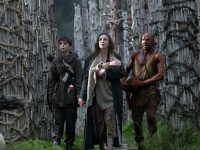
 Acclaimed director Nolan adds texture to one of the horrors of history that still resonates decades later.
Acclaimed director Nolan adds texture to one of the horrors of history that still resonates decades later.
Bleak, wet and with dwindling hope, four hundred thousand men await their fate, at the mercy of the crumbling rearguard, a navy and air force stretched thin and the unstoppable approach of their mortal enemy. Nolan captures every unglamorous moment, breaking for occasional glimmers of light that highlight outstanding acts of selfless bravery.
Nolan and his powerful cast stand respectfully behind reality. There is no spin or attempt to make history anything more or less than it was. Mark Rylance plays a fatherly pleasure boat skipper. A master of his craft, he demands quiet respect from those around him as he resolutely offers salvation to all he can, summing up the spirit of the nation in his singular performance. Tom Hardy brings rare moments of positive action as a taciturn fighter pilot. His achievements made all the more tangible and wholesome, by the rigid adherence to the very real limitations of the machines of the time. Throughout the movie there is no clichéd slow runs or soldiers kissing the sand of home. The greater body of lesser known actors, including Harry Styles, merge as a unified example of every soldier’s experiences and emotional journey. Styles, in particular, could have been singled out as a detriment to the movie, this did not happen and his appeal to younger viewers is a benefit. It is a credit to the casting choice and 12a Certification, that this important moment in history and its message appeals to all appropriate age groups. The reminder of unity across borders and the value of preserving life is particularly timely in today’s climate. Nolan’s choice to refrain from almost any reference to the Nazis is another exceptional device, heightening the shock and fear of each encounter in a way that is reminiscent of Paranormal Activity. The faceless enemy also makes the narrative more relevant to understanding and empathising with all conflict, focusing us on the horrors of war and the men hoping for survival.
Every frame is shot with 70mm IMAX cameras, taking great care and artistic vision to create a work of art and beauty, in this way Dunkirk is a cinematic masterpiece. Contrasting moments of breathtaking natural beauty with swirling grey and turgid water, Nolan tells a visual story with little need for words. Odd filming angles on sinking ships, the forward-facing cockpit views during dog fights and wide panoramic shots all contribute to the incredible visual dynamism.
In short this is a must see movie, it does not require pigeonholing as a must see war classic or thriller, it creates its own space in cinematic history. It is relevant now and will continue to be. It is both technically brilliant, emotive and requires very little of you but your empathy. The latter point I make purely to reassure that Nolan uses a nuanced version of his usual style, the fractured timeline only emphasizes the chaotic nature of the events. Designed for the big screen and with a big story to tell I hope you enjoy this film as much as I did.

Author: Joe, Bath Store





